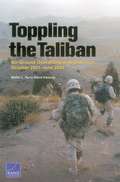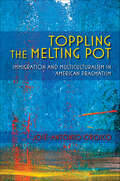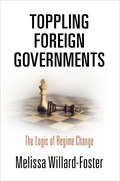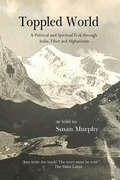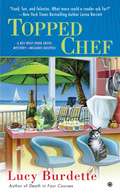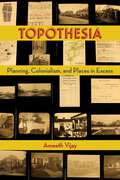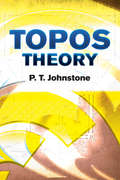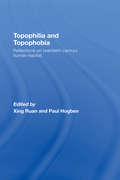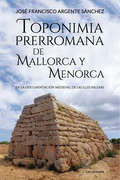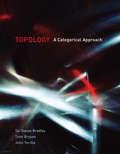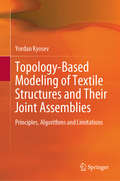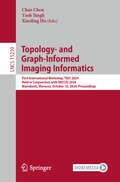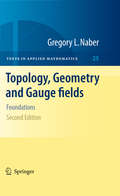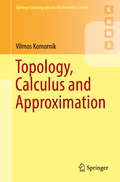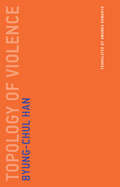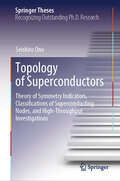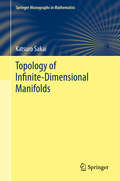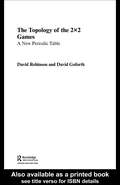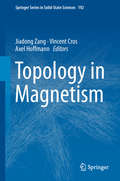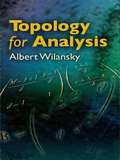- Table View
- List View
Toppling the Taliban
by Walter L. Perry David KassingOn September 11, 2001, the United States was without a plan for military operations in Afghanistan. One was quickly created by the Defense Department and operations began October 7. The Taliban was toppled in less than two months. This report describes preparations at CENTCOM and elsewhere, Army operations and support activities, building a coalition, and civil-military operations in Afghanistan from October 2001 through June 2002.
Toppling the Melting Pot: Immigration and Multiculturalism in American Pragmatism (American Philosophy)
by José-Antonio OroscoThe catalyst for much of classical pragmatist political thought was the great waves of migration to the United States in the early twentieth century. José-Antonio Orosco examines the work of several pragmatist social thinkers, including John Dewey, W. E. B. Du Bois, Josiah Royce, and Jane Addams, regarding the challenges large-scale immigration brings to American democracy. Orosco argues that the ideas of the classical pragmatists can help us understand the ways in which immigrants might strengthen the cultural foundations of the United States in order to achieve a more deliberative and participatory democracy. Like earlier pragmatists, Orosco begins with a critique of the melting pot in favor of finding new ways to imagine the civic role of our immigrant population. He concludes that by applying the insights of American pragmatism, we can find guidance through controversial contemporary issues such as undocumented immigration, multicultural education, and racialized conceptions of citizenship.
Toppling Trump: How Party Elites Steered Joe Biden to the Democratic Nomination and Victory in the 2020 Presidential Election. (Springer Series in Electoral Politics)
by Samuel J. Best Jeffrey W. LadewigThis book tells the story of the 2020 presidential election campaign, exploring how Joe Biden secured the Democratic nomination and defeated Donald Trump in the general election. It argues that Democratic Party elites paved the way for Biden’s victory, enabling him to overcome numerous campaign missteps to defeat one of the largest, wealthiest, most competitive fields in history. It details how elites discouraged potential rivals from entering the race, orchestrated rules to truncate the field, and steered voters toward Biden’s candidacy both directly and indirectly. It shows how they helped the Biden campaign overcome early defeats in the first several contests and turn his campaign around. And it shows the critical role they played in mobilizing partisans to help Biden win the general election campaign and thwarting efforts to undermine his victory. Simply put, the book demonstrates that Biden would not have won the White House without maneuvering and manipulation by the Democratic establishment.
Toppling Qaddafi
by Christopher S. ChivvisToppling Qaddafi is a carefully researched, highly readable look at the role of the United States and NATO in Libya's war of liberation and its lessons for future military interventions. Based on extensive interviews within the US government, this book recounts the story of how the United States and its European allies went to war against Muammar Qaddafi in 2011, why they won the war, and what the implications for NATO, Europe, and Libya will be. This was a war that few saw coming, and many worried would go badly awry, but in the end the Qaddafi regime fell and a new era in Libya's history dawned. Whether this is the kind of intervention that can be repeated, however, remains an open question - as does Libya's future and that of its neighbors.
Toppling Foreign Governments: The Logic of Regime Change
by Melissa Willard-FosterIn 2011, the United States launched its third regime-change attempt in a decade. Like earlier targets, Libya's Muammar Qaddafi had little hope of defeating the forces stacked against him. He seemed to recognize this when calling for a cease-fire just after the intervention began. But by then, the United States had determined it was better to oust him than negotiate and thus backed his opposition. The history of foreign-imposed regime change is replete with leaders like Qaddafi, overthrown after wars they seemed unlikely to win. From the British ouster of Afghanistan's Sher Ali in 1878 to the Soviet overthrow of Hungary's Imre Nagy in 1956, regime change has been imposed on the weak and the friendless.In Toppling Foreign Governments, Melissa Willard-Foster explores the question of why stronger nations overthrow governments when they could attain their aims at the bargaining table. She identifies a central cause—the targeted leader's domestic political vulnerability—that not only gives the leader motive to resist a stronger nation's demands, making a bargain more difficult to attain, but also gives the stronger nation reason to believe that regime change will be comparatively cheap. As long as the targeted leader's domestic opposition is willing to collaborate with the foreign power, the latter is likely to conclude that ousting the leader is more cost effective than negotiating.Willard-Foster analyzes 133 instances of regime change, ranging from covert operations to major military invasions, and spanning over two hundred years. She also conducts three in-depth case studies that support her contention that domestically and militarily weak leaders appear more costly to coerce than overthrow and, as long as they remain ubiquitous, foreign-imposed regime change is likely to endure.
Toppleton's Client
by John Kendrick BangsAn extravaganza that ranges all the way from dry Stocktonian humor to roaring farce. The central idea is that of the exchange of souls between bodies, and we may easily imagine the opportunities it offers a writer intent only upon the possible humorous complications. The "client" is an exiled spirit whose body is occupied by a usurping fiend, and who engages Toppleton (a lawyer whose chief work of reference is the "Comic Blackstone") to possess him once more of the bodily estate that he has lost. But the fiend is too sharp for the lawyer, and, preferring Toppleton's corporeal tenement to that in which he has been fraudulently dwelling, effects a substitution, and leaves Toppleton helpless, either to protect the rights of his client or to re-establish his own.
Toppled World: A Political and Spiritual Trek through India, Tibet and Afghanistan
by Susan MurphyIt was Spring of 1959 and the Chinese occupation of Tibet was in full swing. In the midst of all the turmoil and unease was Sudha Johorey, wife of the political officer in charge of the Indian Mission in Yatung, worried about the state of affairs for her beloved Tibet, the souring relationship between India and China and above all her friend, HH The Dalai Lama who was rumored to have left Lhasa for sanctuary in India. Thus begins the extraordinary journey of a young woman and her unlikely friendship with HH The Dailai Lama, her adventures as a diplomat’s wife across India, Afghanistan, and the jungles of frontier states of her country and her unique and personal journey with the teachings of the Buddha. Toppled World is a moving personal account of the life of Sudha Johorey and a rare glimpse into the events that shaped India in the early years of independence as well as her own spiritual philosophy, as recounted to her dear friend Susan Murphy through stories and memories.
Topping Tora
by Laura BacchiTora Wolff craves domination, and at Club Xotica, she expects to get it. When the man who tops her at work shows up to top her at play, Tora can't believe her bad luck. And she hasn't even found the dead body yet...Jovan Creel wants a woman who's willing to submit, and not just any woman. He wants Tora. But after all the fun and games are over, will she want him?When Tora decides to explore her submissive side with another man, someone more experienced--and much more dangerous--Jovan soon discovers it's not a question of Tora wanting him when she returns to Atlanta. It's a question of whether she can return at all.Content Notes: D/s, non-sexual graphic violence, multiple partners, M-M-F, F-F, heavy spanking, light bondage, anal sex.
Topped Chef
by Lucy BurdetteHayley Snow loves her job as the food critic for Key Zest magazine, tasting the offerings from Key West's most innovative restaurants. She'd rate her life four stars, until she's forced into the spotlight...and another murder investigation. Hoping for some good publicity, Hayley's boss signs her up to help judge the Key West Topped Chef contest. Stakes are high as the winner could be the next cooking-show superstar. Hayley shows up for the filming nervous but excited, until she sees who's on the judging panel with her: Sam Rizzoli, big shot businessman--and owner of the restaurant she just panned in her first negative review. When Rizzoli turns up dead, the police assume his killer is one of his business rivals. But Hayley wonders whether someone is taking the contest a little too seriously. With the police following the wrong recipe, it's up to Hayley to find the killer before she's eliminated from the show...permanently.
Topothesia: Planning, Colonialism, and Places in Excess
by Ameeth VijaySHORTLISTED, 2024 MSA FIRST BOOK PRIZETopothesia reads urban planning as a mode of speculative fiction, one inextricably linked to histories of British colonialism and liberalism through a particular understanding of place. The book focuses on town planning from the late nineteenth century to the present day, showing how the contemporary geography of Britain—sharply unequal and marked by racial division—continues ideologies of place established in colonial contexts. Specifically, planning allows for the speculative construction of future places that are both utopian in their ability to resolve political disagreement and at the same tantalizingly realizable, able to be produced in concrete reality. This speculative imaginary, I argue, is only possible within the ideological framework of colonialism and the history of empire within which it developed. Topothesia refers to a rhetorical device employing the vivid depiction of an often-imaginary place. This device, Vijay shows, helps us understand urban planning as a narrative genre, one that, even in its most mundane documents, is compelled to produce elaborate fantasies of future places. The book examines specific planning movements over time to understand the form and the stakes of their speculative worlds. In building these worlds, the book shows, planners continually coopted literary critiques of the present and reveries of the future, retaining literature's aesthetics while eschewing its politics. At the same time, Vijay shows, writers and artists have dwelled within and against these colonial imaginaries to seek other means of representing place.
Topos Theory (Dover Books on Mathematics)
by P. T. JohnstoneOne of the best books on a relatively new branch of mathematics, this volume focuses on how topos theory integrates geometric and logical ideas into the foundations of mathematics and theoretical computer science. Topics include internal category theory, topologies and sheaves, geometric morphisms, natural number objects, cohomology, set theory, and more. 1977 edition.
Topophrenia: Place, Narrative, and the Spatial Imagination (The Spatial Humanities)
by Robert T. Tally Jr.What is our place in the world, and how do we inhabit, understand, and represent this place to others? Topophrenia gathers essays by Robert Tally that explore the relationship between space, place, and mapping, on the one hand, and literary criticism, history, and theory on the other. The book provides an introduction to spatial literary studies, exploring in detail the theory and practice of geocriticism, literary cartography, and the spatial humanities more generally. The spatial anxiety of disorientation and the need to know one's location, even if only subconsciously, is a deeply felt and shared human experience. Building on Yi Fu Tuan's "topophilia" (or love of place), Tally instead considers the notion of "topophrenia" as a simultaneous sense of place-consciousness coupled with a feeling of disorder, anxiety, and "dis-ease." He argues that no effective geography could be complete without also incorporating an awareness of the lonely, loathsome, or frightening spaces that condition our understanding of that space. Tally considers the tension between the objective ordering of a space and the subjective ways in which narrative worlds are constructed. Narrative maps present a way of understanding that seems realistic but is completely figurative. So how can these maps be used to not only understand the real world but also to put up an alternative vision of what that world might otherwise be? From Tolkien to Cervantes, Borges to More, Topophrenia provides a clear and compelling explanation of how geocriticism, the spatial humanities, and literary cartography help us to narrate, represent, and understand our place in a constantly changing world.
Topophilia and Topophobia: Reflections on Twentieth-Century Human Habitat
by Xing RuanThis book is about the love and hate relations that humans establish with their habitat, which have been coined by discerning modern thinkers as topophilia and topophobia. Whilst such affiliations with the topos, our manmade as well as natural habitat, have been traced back to antiquity, a wide range of twentieth-century cases are studied here and reflected upon by dwelling on this framework. The book provides a timely reminder that the qualitative aspects of the topos, sensual as well as intellectual, should not be disregarded in the face of rapid technological development and the mass of building that has occurred since the turn of the millennium.Topophilia and Topophobia offers speculative and historical reflections on the human habitat of the century that has just passed, authored by some of the world’s leading scholars and architects, including Joseph Rykwert, Yi-Fu Tuan, Vittorio Gregotti and Jean-Louis Cohen. Human habitats, ranging broadly from the cities of the twentieth century, highbrow modern architecture both in Western countries and in Asia, to non-architect/planner designed vernacular settlements and landscapes are reviewed under the themes of topophilia and topophobia across the disciplines of architecture, landscape studies, philosophy, human geography and urban planning.
Toponimia Prerromana de Mallorca y Menorca: En la documentación medieval de las Illes Balears
by José Francisco Argente Sánchez¿Qué secreto esconden los nombres de lugar más antiguos de las Illes Balears? La historia se sitúa cuando las tropas de Jaime I el Conquistador arrebataron Mallorca a los árabes en 1229; una vez asegurado el territorio, dejaron valiosos códices repartimentales de tierras y fincas que ofrecían, entre nombres de lugar latinos, árabes o catalanes, valiosos restos lingüísticos de las culturas prerromanas que habitaron las islas. Y es que, al llegar a Mallorca el cónsul Quinto Cecilio Metelo, en el año 123 antes de nuestra Era, hacía ya más de dos mil años que las islas estaban habitadas. Pues existía un sustrato toponímico indígena importante, mucho mayor que los escasos restos citados por los autores clásicos, como Bocchorum, Guium o Tucis. De alguno de esos fósiles toponímicos trata este libro.
Topology: A Categorical Approach
by Tai-Danae Bradley Tyler Bryson John TerillaA graduate-level textbook that presents basic topology from the perspective of category theory.This graduate-level textbook on topology takes a unique approach: it reintroduces basic, point-set topology from a more modern, categorical perspective. Many graduate students are familiar with the ideas of point-set topology and they are ready to learn something new about them. Teaching the subject using category theory--a contemporary branch of mathematics that provides a way to represent abstract concepts--both deepens students' understanding of elementary topology and lays a solid foundation for future work in advanced topics.
Topology-Based Modeling of Textile Structures and Their Joint Assemblies: Principles, Algorithms And Limitations
by Yordan KyosevThis book presents the textile-, mathematical and mechanical background for the modelling of fiber based structures such as yarns, braided and knitted textiles. The hierarchical scales of these textiles and the structural elements at the different levels are analysed and the methods for their modelling are presented. The author reports about problems, methods and algorithms and possible solutions from his twenty year experience in the modelling and software development of CAD for textiles.
Topology- and Graph-Informed Imaging Informatics: First International Workshop, TGI3 2024, Held in Conjunction with MICCAI 2024, Marrakesh, Morocco, October 10, 2024, Proceedings (Lecture Notes in Computer Science #15239)
by Chao Chen Xiaoling Hu Yash SinghThis book constitutes the proceedings of the First International Workshop on Topology- and Graph-Informed Imaging Informatics, TGI3 2024, held in conjunction with the 27th International conference on Medical Image Computing and Computer Assisted Intervention, MICCAI 2024, in Marrakesh, Morocco in October 2024. The 13 full papers presented here were carefully reviewed and selected. These papers focus on the application of Topological Data Analysis (TDA) techniques, along with other computational techniques, for summarizing, analyzing, quantifying, and visualizing complex medical data for a more effective and efficient analysis.
Topology, Geometry and Gauge fields
by Gregory L. NaberLike any books on a subject as vast as this, this book has to have a point-of-view to guide the selection of topics. Naber takes the view that the rekindled interest that mathematics and physics have shown in each other of late should be fostered, and that this is best accomplished by allowing them to cohabit. The book weaves together rudimentary notions from the classical gauge theory of physics with the topological and geometrical concepts that became the mathematical models of these notions. The reader is asked to join the author on some vague notion of what an electromagnetic field might be, to be willing to accept a few of the more elementary pronouncements of quantum mechanics, and to have a solid background in real analysis and linear algebra and some of the vocabulary of modern algebra. In return, the book offers an excursion that begins with the definition of a topological space and finds its way eventually to the moduli space of anti-self-dual SU(2) connections on S4 with instanton number -1.
Topology, Calculus and Approximation
by Vilmos KomornikPresenting basic results of topology, calculus of several variables, and approximation theory which are rarely treated in a single volume, this textbook includes several beautiful, but almost forgotten, classical theorems of Descartes, Erdős, Fej#65533;r, Stieltjes, and Tur#65533;n. The exposition style of Topology, Calculus and Approximation follows the Hungarian mathematical tradition of Paul Erdős and others. In the first part, the classical results of Alexandroff, Cantor, Hausdorff, Helly, Peano, Radon, Tietze and Urysohn illustrate the theories of metric, topological and normed spaces. Following this, the general framework of normed spaces and Carath#65533;odory's definition of the derivative are shown to simplify the statement and proof of various theorems in calculus and ordinary differential equations. The third and final part is devoted to interpolation, orthogonal polynomials, numerical integration, asymptotic expansions and the numerical solution of algebraic and differential equations. Students of both pure and applied mathematics, as well as physics and engineering should find this textbook useful. Only basic results of one-variable calculus and linear algebra are used, and simple yet pertinent examples and exercises illustrate the usefulness of most theorems. Many of these examples are new or difficult to locate in the literature, and so the original sources of most notions and results are given to help readers understand the development of the field.
Topology of Violence (Untimely Meditations #9)
by Byung-Chul HanOne of today's most widely read philosophers considers the shift in violence from visible to invisible, from negativity to excess of positivity. Some things never disappear—violence, for example. Violence is ubiquitous and incessant but protean, varying its outward form according to the social constellation at hand. In Topology of Violence, the philosopher Byung-Chul Han considers the shift in violence from the visible to the invisible, from the frontal to the viral to the self-inflicted, from brute force to mediated force, from the real to the virtual. Violence, Han tells us, has gone from the negative—explosive, massive, and martial—to the positive, wielded without enmity or domination. This, he says, creates the false impression that violence has disappeared. Anonymized, desubjectified, systemic, violence conceals itself because it has become one with society. Han first investigates the macro-physical manifestations of violence, which take the form of negativity—developing from the tension between self and other, interior and exterior, friend and enemy. These manifestations include the archaic violence of sacrifice and blood, the mythical violence of jealous and vengeful gods, the deadly violence of the sovereign, the merciless violence of torture, the bloodless violence of the gas chamber, the viral violence of terrorism, and the verbal violence of hurtful language. He then examines the violence of positivity—the expression of an excess of positivity—which manifests itself as over-achievement, over-production, over-communication, hyper-attention, and hyperactivity. The violence of positivity, Han warns, could be even more disastrous than that of negativity. Infection, invasion, and infiltration have given way to infarction.
Topology of Superconductors: Theory of Symmetry Indicators, Classifications of Superconducting Nodes, and High-Throughput Investigations (Springer Theses)
by Seishiro OnoThis book develops a symmetry-based approach to superconductors, which enables us to efficiently diagnose topological and nodal superconductivity. Superconductivity has fascinated physicists since its first discovery. In particular, unconventional superconductivity, which arises from unusual attractive interactions between electrons, has been intensively studied for the last few decades. More recently, it turns out that topological nature of superconductivity is closely related to how electrons pair up. After reviewing the basic concepts of the symmetry-based analysis of band topology, the first part of this book discusses a generalization of symmetry-based indicators—an efficient way to diagnose topological insulating phases without full information on wave functions—to superconducting phases. The second part of this book develops a novel scheme to extensively classify superconducting nodes—geometry of gapless regions in the Bogoliubov quasiparticle spectrum—based on band topology.Finally, combining these two parts, this book proposes a systematic scheme to predict topological and nodal properties of the superconducting phase by considering various possible pairing symmetries.
Topology of Infinite-Dimensional Manifolds (Springer Monographs in Mathematics)
by Katsuro SakaiAn infinite-dimensional manifold is a topological manifold modeled on some infinite-dimensional homogeneous space called a model space. In this book, the following spaces are considered model spaces: Hilbert space (or non-separable Hilbert spaces), the Hilbert cube, dense subspaces of Hilbert spaces being universal spaces for absolute Borel spaces, the direct limit of Euclidean spaces, and the direct limit of Hilbert cubes (which is homeomorphic to the dual of a separable infinite-dimensional Banach space with bounded weak-star topology). This book is designed for graduate students to acquire knowledge of fundamental results on infinite-dimensional manifolds and their characterizations. To read and understand this book, some background is required even for senior graduate students in topology, but that background knowledge is minimized and is listed in the first chapter so that references can easily be found. Almost all necessary background information is found in Geometric Aspects of General Topology, the author's first book. Many kinds of hyperspaces and function spaces are investigated in various branches of mathematics, which are mostly infinite-dimensional. Among them, many examples of infinite-dimensional manifolds have been found. For researchers studying such objects, this book will be very helpful. As outstanding applications of Hilbert cube manifolds, the book contains proofs of the topological invariance of Whitehead torsion and Borsuk’s conjecture on the homotopy type of compact ANRs. This is also the first book that presents combinatorial ∞-manifolds, the infinite-dimensional version of combinatorial n-manifolds, and proofs of two remarkable results, that is, any triangulation of each manifold modeled on the direct limit of Euclidean spaces is a combinatorial ∞-manifold and the Hauptvermutung for them is true.
Topology of 2x2 Games
by David Robinson David GoforthGame theory has implications for all the social sciences and beyond. It now provides the theoretical basis for almost all teaching in economics, and 2x2 games provide the very basis of game theory. Here, Goforth and Robinson here have delivered a well-written and knowledgeable, 'periodic table' of the most common games including: * the prisoner's dilemma* coordination games* chicken* the battle of the sexes. This book will provide a valuable reference for students of microeconomics and business mathematics.
Topology in Magnetism (Springer Series In Solid-state Sciences Ser. #192)
by Jiadong Zang Vincent Cros Axel HoffmannThis book presents both experimental and theoretical aspects of topology in magnetism. It first discusses how the topology in real space is relevant for a variety of magnetic spin structures, including domain walls, vortices, skyrmions, and dynamic excitations, and then focuses on the phenomena that are driven by distinct topology in reciprocal momentum space, such as anomalous and spin Hall effects, topological insulators, and Weyl semimetals. Lastly, it examines how topology influences dynamic phenomena and excitations (such as spin waves, magnons, localized dynamic solitons, and Majorana fermions). The book also shows how these developments promise to lead the transformative revolution of information technology.
Topology for Analysis (Dover Books on Mathematics)
by Albert WilanskyAppropriate for both students and professionals, this volume starts with the first principles of topology and advances to general analysis. Three levels of examples and problems, ordered and numbered by degree of difficulty, illustrate important concepts. A 40-page appendix, featuring tables of theorems and counter examples, provides a valuable reference.From explorations of topological space, convergence, and separation axioms, the text proceeds to considerations of sup and weak topologies, products and quotients, compactness and compactification, and complete semimetric space. The concluding chapters explore metrization, topological groups, and function spaces. Each subject area is supplemented with examples, problems, and exercises that progress to increasingly rigorous levels. All examples and problems are classified as essential, optional, and advanced.
